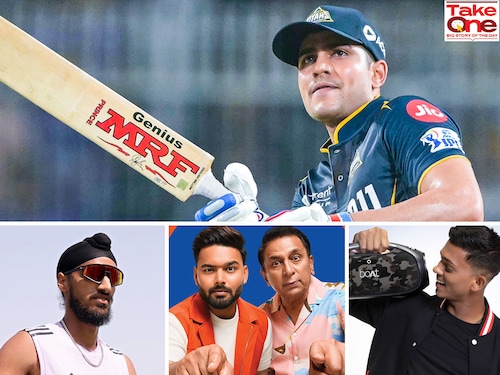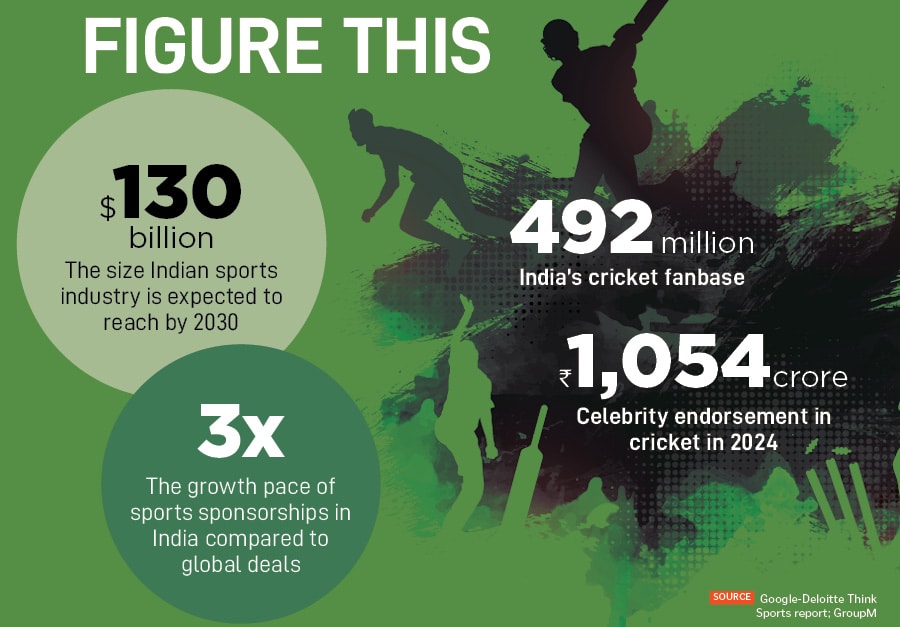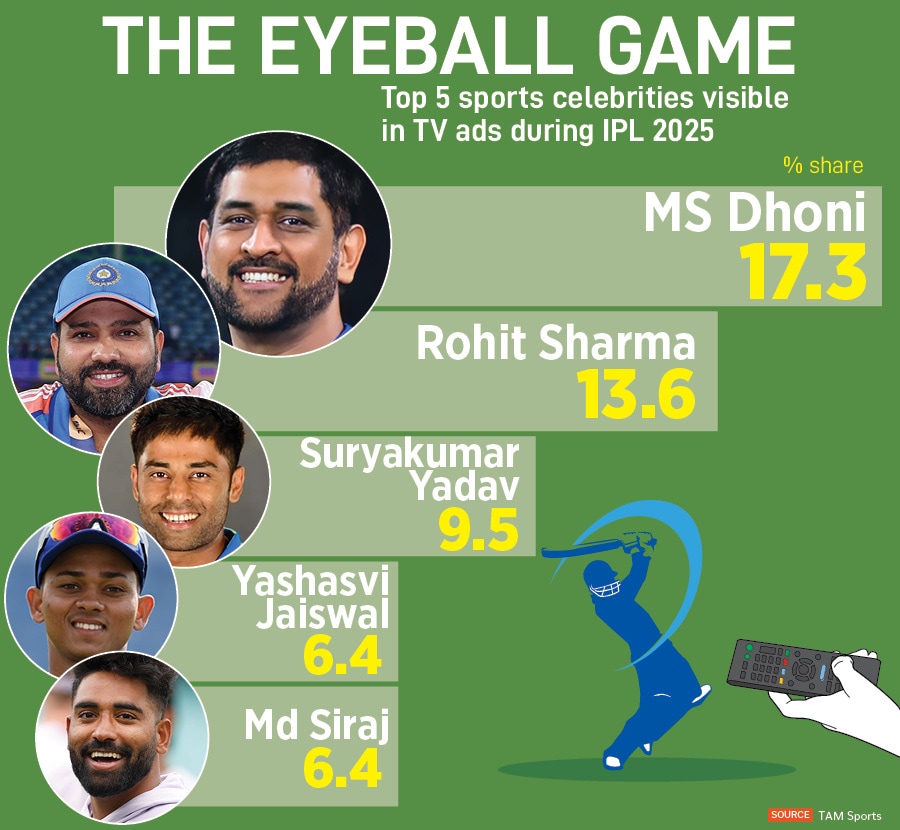The million-dollar pitch: Who'll be the next iconic cricketing brand?
As legends like Virat Kohli and Rohit Sharma retire from Tests, the transition generation led by Shubman Gill will look to step into their shoes, both on and off the field


In 2001, Sachin Tendulkar made headlines for a century that didn’t come off his bat. While, by then, he had already scored a mindboggling 50 tons on the field, this time, he breached the three-figure mark off it. In a first for an Indian athlete, the batting legend signed a Rs100-crore deal with WorldTel, a sports management firm led by the late Mark Mascarenhas.
Tendulkar isn’t a stranger to jaw-dropping numbers. Nearly 12 years after retirement, he still holds the record for the highest international runs. But his five-year deal with the Indian-origin, US-based Mascarenhas wasn’t just a personal milestone—it ushered a cricketing perestroika that reshaped player brand valuations.
As the Think Sports report, jointly authored by Google and Deloitte, states, the Indian sports market is expected to reach $130 billion by 2030, from the present $52 billion sports sponsorship values in India have grown at triple the pace of global deals. Meanwhile, Virat Kohli, the cricketer who took up the mantle from Tendulkar as not only his generation’s most celebrated cricketer but also the most marketable athlete, touched $227.9 million in brand valuation, up $51 million year-on-year (as per the Kroll Celebrity Valuation Report, 2023 Kohli’s valuation would have multiplied since).
Among the top 20 most valued celebrities on that list are five athletes, all of whom are cricketers. As two of them—Kohli and Rohit Sharma (valued at $41 million)—have announced their retirement from Test cricket, and a team led by Shubman Gill begins its first assignment in an away series against England, the search for cricket’s next iconic brand stands second only to the quest for a batter who can fill in for Kohli at No 4.
“Transition periods are interesting because they create a fresh playground for cricketers to build their equity," says Ajimon Francis, managing director of Brand Finance India, a valuation consultancy. “The England series has been a tough challenge for most Indian teams and captains. It will be a baptism by fire for Shubman and will help him define his character and equity."

Gill, the batter, will have a point to prove for his not-so-enviable record in bowler-friendly SENA (South Africa, England, New Zealand, Australia) countries, where he averages 25ish in 21 innings—in six Test innings against England, he aggregates a modest 88 runs. But into a new role as a captain and helming a generation that’s in transition, he will have the comfort of a clean slate to work with. Besides, his career stats prove he’s no pushover. While 2024 has been a mixed bag—especially compared to 2023 when he was the year’s most prolific international batter—Gill is showing signs of resurgence this year, having already notched two centuries and as many fifties in nine innings.
The uptick isn’t just on the pitch, but also reflects in a growing commercial footprint—sources say Gill has about a dozen brands in his portfolio, ranging from legacy companies like Nike and Coca-Cola to startups like My11 Circle his annual endorsement income has risen from Rs40 crore last year to around Rs60 crore now.
A bunch of athlete managers that Forbes India spoke to concur that the 25-year-old is the frontrunner in emulating the brand worth of Tendulkar and Kohli. The fact that their anointed heir was recently onboarded by MRF—a logo that most cricket fans have come to associate with the two Indian greats—is a symbolism hard to miss. Gill’s three-year bat sponsorship deal with the tyre manufacturer comes for a reported Rs35 crore.

“He’s young, he’s become captain early, there is a classical flair to how he plays," says Santosh Desai, MD and CEO of Futurebrands Consulting. “Plus, he’s seen in the ‘right’ social circles, has the right persona. Gill has the potential to become a celebrity over and above being a hero."
The last bit, adds Desai, is as important in building a cricketer’s brand as performance. “Performance is the start of everything it brings in endorsements. But, while almost every cricketer will do endorsements, only some will shape up to be iconic brands," he says. “They have to mean something in the larger picture."
Tendulkar, for example, dominated fast bowlers at a time playing pace used to be an Achilles heel for Indians, Kohli’s high-octane intensity became aspirational, while Mahendra Singh Dhoni’s ability to stay unflappable under pressure sustained his brand equity much after his heydays. Even five years after his international retirement, the TAM-AdEx India Celebrity Endorsement Report 2024 ranks Dhoni fourth among the top 10 most visible endorsers on television, with a cumulative 12.5 hours/day of ad visibility across channels. “On the other hand, Jasprit Bumrah has been the best bowler in the world for quite some time, but doesn’t yet represent something larger that makes him an iconic brand," adds Desai.
At the heart of brand-building lies storytelling beyond mere statistics. Take, for example, 23-year-old Jaiswal’s stellar ascent from selling pani puri in Mumbai to being an all-format cricketer for India, with five international centuries and 15 fifties. “It’s a story of determination. If you are smart, you will build his brand leveraging that aspect," Desai says further.
 It’s an entry point brands have zeroed in on already. In about two years since his international debut, Jaiswal’s surge as a gritty opener has seen him bag 10 endorsements sources estimate his fees to have gone up 2.5x to 3x during this period, ranging between Rs1.25 crore and Rs1.5 crore. Jaiswal was also the fourth-most visible cricketer on television ads during IPL (Indian Premier League) 2025—after Dhoni, Sharma and Suryakumar Yadav—with a 6.4 percent share of ad volumes, according to the TAM Celebrity Endorsement Report.
It’s an entry point brands have zeroed in on already. In about two years since his international debut, Jaiswal’s surge as a gritty opener has seen him bag 10 endorsements sources estimate his fees to have gone up 2.5x to 3x during this period, ranging between Rs1.25 crore and Rs1.5 crore. Jaiswal was also the fourth-most visible cricketer on television ads during IPL (Indian Premier League) 2025—after Dhoni, Sharma and Suryakumar Yadav—with a 6.4 percent share of ad volumes, according to the TAM Celebrity Endorsement Report.
Last April, audio and hearables company boAt signed him on as an ambassador, inspired by his story of “resilience, ambition, and hustle". “Much like our early partnerships with Hardik Pandya, Shreyas Iyer or Jasprit Bumrah, we see Yashasvi as part of that same continuum—young, hungry and on the cusp of greatness. His rise mirrors the aspirations of young India," says Aman Gupta, co-founder and CMO.
How brands love a story is evident from the upward trajectory of Rishabh Pant, who now endorses 25 brands, a 100 percent increase from two years ago, when he was recovering from a near-fatal car crash that took place in December 2022. Industry insiders say the endorsement fees for Pant, the vice captain for the England tour, have also doubled since his accident, to reach somewhere around Rs2.5 crore to Rs3 crore.
In December, the keeper-batter became the most expensive player in the IPL mega auction, commanding a price tag of Rs27 crore from Lucknow Super Giants (LSG)—his team has since closed or is on the verge of closing 10-odd deals, all but one of which are long-term associations. “With Pant, you have an individual who is loved by fans across generations. He has an inspirational story—the way he has come back with the T20 World Cup, the IPL auction, Team India leadership role and as arguably the best ever Test keeper-batter for India is a story for the ages. It has also earned him an acknowledgement from the Laureus World Sports Awards. We’ve seen a significant increase in his portfolio since the accident," say Indranil Das Blah and Anant Arora, Pant’s business managers.

While a compelling narrative remains a leitmotif across generations, brand-building itself has undergone a sea change, given the exposure to 24x7 media and the rise of social media. “When Sachin was coming up, it was one-way communication—you saw the guy from afar and weren’t yearning to get close to him," says Hemant Dua, CEO of the Seattle Orcas in Major League Cricket (MLC), the newly minted T20 franchise league in the US. “Now, fans can be close to the players every day on social media. How you capitalise on that is the key." As a result, brand-building has become way more challenging despite the ease of resources.
Even players have woken up to the omnipresence of digital media and the onslaught of snacky, round-the-clock content: Sharma has a dedicated four-member team to film content for social media, Shreyas Iyer doesn’t mind dancing for Instagram reels, Gill travels with a cameraman for BTS footage that his team is archiving for the future, while R Ashwin hosts a YouTube channel that already has 1.71 million followers. Compare that to Rahul Dravid, a batting legend and a World Cup-winning coach, who has a 20+ brand roster with zero presence on social media.

“The younger generation understands media currency and how to build their commercial legacy, which is why most deals aren’t about a day or a year, as it would have been in the past. It has transcended to what value am I creating for myself," says an athlete manager on condition of anonymity. “For example, if it’s a young brand onboarding a young athlete, it doesn’t take them a minute to start a new line with a cricketer’s name. Fifteen years ago, it wouldn’t happen with every other cricketer. The more the market opens up and more the younger companies, more are the opportunities for an athlete to not just do endorsements but actually build a brand."
As a result, the nature of deals has also changed from purely linear contracts to some that are a mix of endorsement and investment (equity plus cash deals), says Vishal Jaison, co-founder, Baseline Ventures, a player management agency. It’s a trend that has found global resonance—tennis legend Roger Federer is estimated to have earned around $360 million, 3x of his on-court earnings, from a 3 percent equity stake in Swiss running shoe company On. In India, the likes of Tendulkar, Kohli and Dhoni are known to have done a rash of equity and investment deals—Kohli’s latest is in Agilitas, a sports and athleisure brand, that he chose over renewing a reported Rs300 crore deal with Puma. “It helps them diversify their portfolio and enhance the scope of their brand," says Joshney John, director and sales head, ITW Universe, sports, entertainment and media consultants.
But jumping headlong into equity deals might be a little premature for the younger generation, says the manager quoted earlier. “At 27/28, they might not be enthused about a brand they are now at 22/23, so equity deals are more appropriate for a time when their career has matured a bit. But the fact that they’re asking whether there is an investment Option on the table suggests how involved and aware the young players are now when it comes to brands."
That age is just a number in cricket was recently driven home by a 14-year-old from Bihar, who became the youngest player to debut in the IPL. Vaibhav Suryavanshi, who turned out for the Rajasthan Royals and ended up hitting the second-fastest century in the tournament, is seen as someone with not just the firepower of hitting sixes but also catching the fancy of brands. To grab him young, of course, but also to tap into his background to foray into middle India.
“He’s going to appeal amazingly to Tier II, Tier III cities—he comes from one, he speaks in Hindi, he looks like the boy-next-door. Seeing him play gives an aspiration to the youngsters, especially those aged between 14 and 20," says Dua of Seattle Orcas, who was earlier CEO of IPL team Delhi Capitals. “He has been selected for the India U-19 team that’s travelling to England, his performance there will be a key factor for his brand value."

While the IPL may be a catapult to the big league, it doesn’t supersede, only complements, international performance when it comes to brand equity. Arshdeep Singh debuted in the IPL in 2019, but one of the first inflection points in his brand journey came after the T20I World Cup in 2022, where he became India’s highest wicket-taker, and followed it up with being the joint-highest wicket-taker of the tournament in India’s victorious World Cup campaign in 2024. “His endorsement count doubled over the next six months," says Avinash Mishra, who manages Singh.
From three brands in 2023, Singh now has 12, while his endorsement revenues have increased 2.5x. “IPL serves as a mass visibility platform—delivering high-frequency, high-decibel exposure. International cricket, on the other hand, builds trust, credibility and legacy. Together, IPL builds momentum and mass appeal, while international performance reinforces depth and reputation," adds Mishra.
Singh’s bowling partner Prasidh Krishna, too, has witnessed a growth in the volume and value of his endorsements since his Test debut in December 2023—in 2025, his endorsements fees have doubled. Nitish Kumar Reddy, who made his India debut in two formats in 2024 following a breakthrough IPL season, now has five sponsors, up from just the one bat sponsor last year. “Brand value is ultimately a factor of relevance and perception. Larger the performance, larger the stage, greater the impact. For that reason, being a cricketer for Team India will always reign supreme," says Rahul Sawhney, Reddy’s agent.
Reddy—who scored a century in the Boxing Day Test match during India’s recent Test series against Australia—has been picked up by Hublot and Puma, brands that were earlier endorsed by Sharma and Kohli, respectively. “Globally, Puma has strategically invested in young and promising athletes. Usain Bolt, for example, was signed as our ambassador at 16. With sporting legends retiring now, we want to tap new potential. Nitish is an outcome of this very strategy," says Karthik Balagopalan, MD, Puma India.
Who among these cricketers will turn into an iconic brand is an answer the next decade will provide. As Gill takes guard in England with his new-look team, the test for him will be to step up to the rarefied levels of the Tendulkars and the Kohlis. In more ways than one.
First Published: Jun 20, 2025, 12:18
Subscribe Now